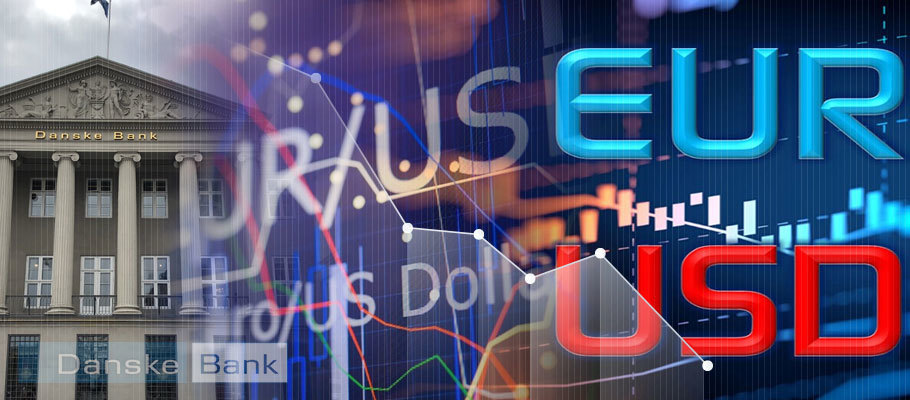
Published: October 26th, 2022
Danish lender Danske Bank has dropped its Euro to Dollar exchange rate forecast, saying the Greenback is heading for new highs while the economic crisis gripping Europe is likely to persist.
In a forex research briefing published this week, Dankse currency analysts said the Eurozone is in the early stages of an extended terms-of-trade shock, which will drag down the single currency.
‘We’ve adjusted our outlook for EURUSD and are now expecting a cross at 0.94 within 12 months due to the substantial trade imbalance brewing between Europe and America.’
The Eurozone’s German-driven trade surplus has gone completely into reverse this year, with a deficit expected by the end of 2022.
The surge in prices for imported oil and gas have caused the price of imported goods to go up, while prices for made-in Europe products have also gone up as overheads and raw materials become more expensive. The combination has dealt a severe economic blow to a continent which is a net importer of energy.
Adding to the region’s pain is a global economic slowdown. Mixed with higher domestic production costs, Europe’s industrial export earnings have fallen off a cliff, setting the stage for negative trade balance that will impact the Euro.
Much of Germany's high-value output goes to China, but an extended slump in the world's second-largest economy has hit German export earnings hard.
The slowdown in the Middle Kingdon is so significant that Beijing officials have delayed the release of the country’s latest GDP figures.
Danske Bank economists say the problems don’t end there, however, as growth risks in the Eurozone have tilted firmly to the downside.
Across the pond in America, USD is only expected to gain in strength, Dankse analysts say.
‘One of the core assumptions built into our currency market forecasts is that a stronger USD will combine with tightening financial conditions globally.’
The world economy is expected to keep on slowing as central bankers continue to raise interest rates and consumers cut back spending as inflation rises.
Spiking oil and gas prices have dragged the Euro into frequent lows this year as forex traders have seen the impact of energy price rises on inflation and guessed the likely response from Frankfurt central bankers.
In February, prices for Brent Crude surged above USD 130 per barrel, the highest level for almost 13 years. Wholesale gas prices meanwhile more than doubled in early March as fears grew that the US and EU were considering a ban on Russian oil.
The US has since moved forward with plans to ban purchases of Russian oil and gas, with a global sanctions regime applied by the G7 countries and beyond. European natural gas prices have responded by hitting several all-time highs.
In a note to investors, the FX Strategy unit at Crédit Agricole wrote in March that news of major Western importers considering coordinated sanctions against Russian energy exports have sent oil and other commodity prices soaring, especially in Asia.
‘Conjecture around ramped up sanctions in the energy sector has started the week with a bang. Stocks have tumbled and crude prices are soaring on Asian markets as traders' price in the impact of Biden’s Tuesday (8th March) ban announcement on Russian crude supplies.’
In response to the sudden supply shock, Crédit Agricole says there has been a ‘binary move’ in currency markets favouring the fiats of energy exporting countries. Net energy importing countries, in contrast, saw their currencies take a hit.
In currency research briefing in April, Barclays said that the Ukraine conflict has delivered a negative EUR shock.
‘In the near term, the Euro has scope to trade lower given the potential stagflation effect on the Eurozone. Looking further ahead, the war could compel more structural integration by member states that provide EUR with support.’
Economists say surging oil and gas prices will continue to pull Europe’s economy downward because so much of its manufacturing octs base is predicated on cheap and reliable imports of Russian gas, which has created deep integration with Russia's energy industry.
Analysts at Barclays added that a negative relationship is strengthening between the price of crude oil and EURUSD.
‘We believe forex traders will devote significant time this week to watching how these variables play out. The risk of an all-out EU ban on Russian oil imports will be one of the most important factors hanging over EURUSD.’
'Rising prices for commodities across the board could force central banks to put the brakes on interest rate rises. That’s impacting EUR sentiment.’
As the Ukraine conflict rages on, Ukraine is trying to pressure the West into banning imports of Russian oil, with the country’s foreign minister telling major news outlets that it comes ‘steeped in Ukrainian blood.’ Many reports have found that oil and gas from Russia is still finding its way into Europe, though deliverd through proxies and priced at a significant premium.
The US government has been engaged with European leaders for months about stopping purchases of Russian oil while also sustaining a reliable global oil supply.
After the Biden administration announced its Russia oil ban, forex traders started considering just how steady supplies of oil will be maintained, and what the impact on crude prices would be.
The EU and UK have said they will cap on how much Russian oil and gas G7 countries can purchase, though Westminster and Brussels have dragged their feet on imposing an outright ban, particularly on imports of liquefied natural gas (LNG).
EU Commission President Ursula von der Leyen said in June that new sanctions on Russia may be coming, but an outright European ban on Russian oil probably isn't in the cards.
‘Our objective has to say focused on isolating Vladimir Putin and make it harder to finance the Ukraine war.’